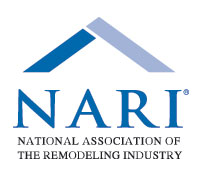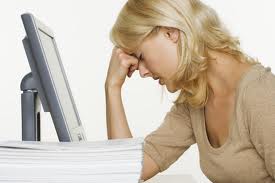EM NARI Members Attend Hearing To Encourage Assistance with RRP Rule in Massachusetts.
12/17/10
 Yesterday Mark Paskell and I attended a hearing held by the Commonwealth of MA Executive Office of Labor and Workforce Development. Interested parties were invited to attend to provide suggestions to Joanne F. Goldstein, the Secretary of Labor and Workforce Development, regarding how the money appropriated to the Department of Labor (DOL) and the Division of Occupational Safety (DOS) should be spent in Fiscal Year 2012. Mark and I were there representing the Government Affairs Committee of the Eastern MA Chapter of the National Association of the Remodeling Industry (EMNARI) and also to share our own personal views. At the meeting we met Mark Casale of Painting and Decorating Specialist, a past National President of the Painting & Decorating Contractors of America (PDCA), who was also there representing his industry’s RRP concerns and encouraging budgetary support related to RRP enforcement.
Yesterday Mark Paskell and I attended a hearing held by the Commonwealth of MA Executive Office of Labor and Workforce Development. Interested parties were invited to attend to provide suggestions to Joanne F. Goldstein, the Secretary of Labor and Workforce Development, regarding how the money appropriated to the Department of Labor (DOL) and the Division of Occupational Safety (DOS) should be spent in Fiscal Year 2012. Mark and I were there representing the Government Affairs Committee of the Eastern MA Chapter of the National Association of the Remodeling Industry (EMNARI) and also to share our own personal views. At the meeting we met Mark Casale of Painting and Decorating Specialist, a past National President of the Painting & Decorating Contractors of America (PDCA), who was also there representing his industry’s RRP concerns and encouraging budgetary support related to RRP enforcement.
Although attending the hearing took time away from my busy work and holiday schedules, I was definitely glad I went. In addition to attending and submitting testimony at the hearing, before the hearing Mark and I also attended a meeting with the MA Division of Occupational Safely to discuss items related to the MA RRP rule, rule administration and rule enforcement.
As I have stated in past blogs and at the RRP Workshops Mark and I present to renovators and their staff, so far I have been very pleased with the efforts of the DOS regarding the RRP Rule. Under the leadership of Heather E. Rowe, the Department’s Acting Commissioner, we have seen significant progress and improvements here in Massachusetts as compared to EPA’s efforts and the EPA RRP rule. I have been fortunate to work with several DOS employees regarding the rule; including Patricia Sutliff, Ernest Kelly and Brian Wong. At our meeting with DOS yesterday, Heather Rowe was also in attendance. She expressed her support of our ideas, recognized our concerns and thanked us for assisting the DOS in dealing with this complex and often times confusing rule. DOS, as part of their takeover of the RRP rule from EPA, inherited many of the same challenges renovators face trying to work with the EPA RRP rule.
 In my opinion, the ability to work with and interact with the same people who not only enforce the rule in MA, but also have the ability to help shape the MA RRP rule, has been a major plus for those Massachusetts contractors affected by the rule. At the budget hearing I shared this opinion and stressed that I hoped DOS would get adequate budgeting to keep such communication opportunities available in the future. Here are a few of the items I suggested at the hearing:
In my opinion, the ability to work with and interact with the same people who not only enforce the rule in MA, but also have the ability to help shape the MA RRP rule, has been a major plus for those Massachusetts contractors affected by the rule. At the budget hearing I shared this opinion and stressed that I hoped DOS would get adequate budgeting to keep such communication opportunities available in the future. Here are a few of the items I suggested at the hearing:
- DOS should have adequate funding to accomplish public and regulated community awareness about the rule so home owners would know to only hire MA Licensed Lead-Safe Renovation Contractors and to assist in getting those who need to be licensed the information they need to do so. Right now in MA, there are approximately 29,000 registered Home Improvement Contractor (HIC) businesses but only about 4000 EPA Certified Firms. Of the 4000 EPA Certified Firms, only approximately 1000 have obtained the required MA Lead-Safe Renovation Contractors License.
- The EPA claims their rule includes lead-safe work practices, but in reality it does not. The EPA rule and the required certified renovator training include lead-safe containment practices. These containment practices actually put workers at greater risk because airborne lead dust becomes concentrated due to the containment, triggering major concerns with worker safety and related OSHA compliance. The EPA does not included lead-safe work practices or training that help renovators eliminate and or dramatically reduce the creation of lead dust to begin with. I stressed that the creation of real lead-safe work practices and training programs to share them with workers would have several benefits. These include a better skilled work force, a higher paid workforce, more taxes collected for the state through payroll taxes on increased wages, compliance with the OSHA Lead In Construction Standards would be easier and less expensive, and the risk of lead poisoning for occupants and those doing the work could be dramatically reduced.
- I also stressed the need for and opportunity to educate our children and young workers to prepare them to meet the needs of the residential construction industry. Teaching lead-safe work practices to students in our state’s vocational and trade schools would help contractors, the students and our state improve worker health and safety in addition to many possible economic benefits for each of the parties.
- I suggested that one of the big opportunities DOS and the regulated community would have if adequate funding was available would be increased awareness of the RRP rule as well as the serious dangers and health effects of lead. Increased awareness could help get more businesses properly licensed. Consumers would be better informed before doing renovations where lead was present and before choosing a contractor to do the work. If more local building inspectors and health departments across the state knew about the rule they could help with awareness and enforcement. And, if we educate young school children about the dangers of lead and how to avoid them, in essence we would be creating a next generation of consumers, workers, business owners and parents who could help carry on a legacy of awareness and respect for the dangers and risks of lead poisoning.
- Both Mark and I stressed the importance of finding and implementing strategies to help level the playing field for honest and hardworking renovators and to help eliminate illegally operating contractors and moonlighters who participate in the underground economy. We encouraged putting RRP related requirements on building permit applications, putting some skin in the game for home owners who hire illegally operating workers and businesses, and providing timely and accurate information and or answers for those businesses and individuals who are trying to do the right thing and are seeking to comply with the RRP Rule.
 EM NARI, Mark Paskell, Mark Casale and I are all committed to both protecting and advancing the professionalism of RRP renovators in MA. The RRP rule is a challenge but also an opportunity for our industry. If we all work together, as individuals and as members of trade associations to help guide, assist and hold accountable those who regulate us; our industry and consumers will all be much better off. I hope you will join us in our efforts and or support us in our efforts. We need all the help and encouragement we can get to help effect change and protect the interests of honest and hardworking professionals affected by the RRP rule.
EM NARI, Mark Paskell, Mark Casale and I are all committed to both protecting and advancing the professionalism of RRP renovators in MA. The RRP rule is a challenge but also an opportunity for our industry. If we all work together, as individuals and as members of trade associations to help guide, assist and hold accountable those who regulate us; our industry and consumers will all be much better off. I hope you will join us in our efforts and or support us in our efforts. We need all the help and encouragement we can get to help effect change and protect the interests of honest and hardworking professionals affected by the RRP rule.

 Looking for accurate information about the EPA RRP rule?
Looking for accurate information about the EPA RRP rule? 
 The recent RRP rule requires contractors to follow certain lead-safe work practices to protect homeowners, their families and the workers who perform work where lead paint is or might be present. The rule also requires training of workers to be sure they know how to do the work, protect themselves and stay in compliance with the rule. Lead poisoning is a real issue. Protecting people from the dangers of lead is the right thing to do. Although we may all have our own opinions about the actual rule itself, as an industry and as professionals, we must do what is right.
The recent RRP rule requires contractors to follow certain lead-safe work practices to protect homeowners, their families and the workers who perform work where lead paint is or might be present. The rule also requires training of workers to be sure they know how to do the work, protect themselves and stay in compliance with the rule. Lead poisoning is a real issue. Protecting people from the dangers of lead is the right thing to do. Although we may all have our own opinions about the actual rule itself, as an industry and as professionals, we must do what is right. Many businesses, ranging from remodelers, subcontractors, manufacturers, distributors, vendors, trainers and even trade associations have contacted me to express their disappointment with EPA’s handling of this rule since it took effect on April 22, 2010. Although EPA claims to have done extensive outreach to consumers and the regulated community, the results of their efforts have proven to be ineffective. Enforcement of the rule so far has been almost non-existent, particularly in light of the number of non-compliant businesses still doing the work in ways that are definitely poisoning our children, their families and those workers who perform renovations where lead is present. The EPA’s June announcement regarding their decision to delay enforcement of the training and firm certification requirements was interpreted by many renovators as a delay of the whole rule, not just the fines for such violations. As a result, many businesses trying to support renovators in complying with the rule have reported that sales have dropped to the point where they must consider shutting down. I could go on with my list but I am probably preaching to the choir.
Many businesses, ranging from remodelers, subcontractors, manufacturers, distributors, vendors, trainers and even trade associations have contacted me to express their disappointment with EPA’s handling of this rule since it took effect on April 22, 2010. Although EPA claims to have done extensive outreach to consumers and the regulated community, the results of their efforts have proven to be ineffective. Enforcement of the rule so far has been almost non-existent, particularly in light of the number of non-compliant businesses still doing the work in ways that are definitely poisoning our children, their families and those workers who perform renovations where lead is present. The EPA’s June announcement regarding their decision to delay enforcement of the training and firm certification requirements was interpreted by many renovators as a delay of the whole rule, not just the fines for such violations. As a result, many businesses trying to support renovators in complying with the rule have reported that sales have dropped to the point where they must consider shutting down. I could go on with my list but I am probably preaching to the choir. Second, if you have suggestions, contacts and or the means to assist me in distributing this information to those who can help us with this important issue, please let me know. Anyone is welcome to leave comments here at the end of this blog. However, I would prefer that you e-mail me your thoughts in letter-like form and that you include your complete contact information as well as your permission to use and distribute what you send me. I will not redistribute information from anonymous parties.
Second, if you have suggestions, contacts and or the means to assist me in distributing this information to those who can help us with this important issue, please let me know. Anyone is welcome to leave comments here at the end of this blog. However, I would prefer that you e-mail me your thoughts in letter-like form and that you include your complete contact information as well as your permission to use and distribute what you send me. I will not redistribute information from anonymous parties. The Commonwealth of MA Executive Office of Labor and Workforce Development will be holding public hearings where interested parties can attend to provide suggestions to Joanne F. Goldstein, the Secretary of Labor and Workforce Development, regarding how the money appropriated to the Department of Labor (DOL) and the Division of Occupational Safety (DOS) should be spent in Fiscal Year 2012.
The Commonwealth of MA Executive Office of Labor and Workforce Development will be holding public hearings where interested parties can attend to provide suggestions to Joanne F. Goldstein, the Secretary of Labor and Workforce Development, regarding how the money appropriated to the Department of Labor (DOL) and the Division of Occupational Safety (DOS) should be spent in Fiscal Year 2012. Proper and effective administration and enforcement of the RRP rule will take money. Because the amount of money the DOS and DOL will get in 2012 is already decided, contractors must voice their opinion as to how they think the money should be spent. It is my opinion that the money could actually be invested in the health and safety of Massachusetts citizens to protect them from the dangers associated with contractors who ignore lead-safe work practices. And, if properly and adequately enforced, the RRP rule would not only help to eliminate the underground construction economy here in Massachusetts, it would also help bring in additional revenue for the state in fees to those who get licensed to do the work, in fines to those who operate illegally and in taxes collected if all construction businesses doing RRP work have to pay their equal share of payroll and income taxes.
Proper and effective administration and enforcement of the RRP rule will take money. Because the amount of money the DOS and DOL will get in 2012 is already decided, contractors must voice their opinion as to how they think the money should be spent. It is my opinion that the money could actually be invested in the health and safety of Massachusetts citizens to protect them from the dangers associated with contractors who ignore lead-safe work practices. And, if properly and adequately enforced, the RRP rule would not only help to eliminate the underground construction economy here in Massachusetts, it would also help bring in additional revenue for the state in fees to those who get licensed to do the work, in fines to those who operate illegally and in taxes collected if all construction businesses doing RRP work have to pay their equal share of payroll and income taxes.  The New Renovation Repair and Painting Rule could likely be a ticking time bomb for many renovators who are ignorant of, intentionally ignoring and or not following all of the many requirements of the rule. The reason I say this is because of the documentation and record keeping requirements of the RRP Rule. Renovators should keep in mind that under the rule the required documentation for each RRP project must be stored and made available for inspection for up to 3 years after the completion of the project. The EPA and or states that have taken over administration and enforcement of the rule won’t be limited to finding active violations of the rule on jobsites. They will also be able to use the required documentation to determine whether renovators were complying with the rule on all projects completed in the three years preceding an inspection. Check out this
The New Renovation Repair and Painting Rule could likely be a ticking time bomb for many renovators who are ignorant of, intentionally ignoring and or not following all of the many requirements of the rule. The reason I say this is because of the documentation and record keeping requirements of the RRP Rule. Renovators should keep in mind that under the rule the required documentation for each RRP project must be stored and made available for inspection for up to 3 years after the completion of the project. The EPA and or states that have taken over administration and enforcement of the rule won’t be limited to finding active violations of the rule on jobsites. They will also be able to use the required documentation to determine whether renovators were complying with the rule on all projects completed in the three years preceding an inspection. Check out this I had a conversation with one remodeler about the serious risks non-compliance can have for a renovator’s business. His opinion was that the risk of being caught was dependent on “how legal” the remodeler is in the way he/she operates the business. My opinion is that being legal is not measured on any kind of graduated scale. You are either operating the business legally or you are not. I think both EPA and OSHA agree with this logic.
I had a conversation with one remodeler about the serious risks non-compliance can have for a renovator’s business. His opinion was that the risk of being caught was dependent on “how legal” the remodeler is in the way he/she operates the business. My opinion is that being legal is not measured on any kind of graduated scale. You are either operating the business legally or you are not. I think both EPA and OSHA agree with this logic.  In a recent
In a recent  In the letter Harris points out that NARI would like to work with the Committee on Small Business & Entrepreneurship to “reiterate to EPA the impact LRRP is having on remodelers and to facilitate a better dialogue on how EPA can implement the LRRP rules in a small business-friendly way” She further goes on to suggest that; ”With the Committee’s help, remodelers and EPA officials can work towards solutions that will better inform homeowners of lead hazards, penalize unlicensed or unethical contractors, and reduce the exposure of children to lead from construction activities”
In the letter Harris points out that NARI would like to work with the Committee on Small Business & Entrepreneurship to “reiterate to EPA the impact LRRP is having on remodelers and to facilitate a better dialogue on how EPA can implement the LRRP rules in a small business-friendly way” She further goes on to suggest that; ”With the Committee’s help, remodelers and EPA officials can work towards solutions that will better inform homeowners of lead hazards, penalize unlicensed or unethical contractors, and reduce the exposure of children to lead from construction activities” On December 2nd, 2010 I attended an
On December 2nd, 2010 I attended an  At the workshop Joe Ceccarelli, a trainer with Safety Trainers, shared some information with the attendees regarding OSHA’s plans to step up inspections and increase fine amounts related to the residential construction Industry. He told us that OSHA Region 1 has hire 250 new additional field inspectors and 40 of those have been assigned to Massachusetts alone. I was quite taken back when Joe told us he had learned that 72% of OSHA violations levied against residential construction businesses were for what OSHA calls “serious or willful violations” and resulted in fines ranging from $3000 to $70,000.
At the workshop Joe Ceccarelli, a trainer with Safety Trainers, shared some information with the attendees regarding OSHA’s plans to step up inspections and increase fine amounts related to the residential construction Industry. He told us that OSHA Region 1 has hire 250 new additional field inspectors and 40 of those have been assigned to Massachusetts alone. I was quite taken back when Joe told us he had learned that 72% of OSHA violations levied against residential construction businesses were for what OSHA calls “serious or willful violations” and resulted in fines ranging from $3000 to $70,000.  The EPA sent out the press release below to announce National Lead Poisoning Prevention Week. Although the announcement mentions the RRP Rule and that contractor training and certification are required, it certainly falls short in giving consumers sound advice about having renovations done at their homes. Earlier this year many in the industry expressed this same concern about the
The EPA sent out the press release below to announce National Lead Poisoning Prevention Week. Although the announcement mentions the RRP Rule and that contractor training and certification are required, it certainly falls short in giving consumers sound advice about having renovations done at their homes. Earlier this year many in the industry expressed this same concern about the  Legitimate businesses have been demanding that EPA enforce the rule and go after illegally operating renovators. This announcement could have assisted in that effort. Had the announcement encouraged consumers to check for and report violators of the rule perhaps we could protect more children. In effect, by not adequately enforcing this rule, the gap between legitimate businesses and the underground economy is widening.
Legitimate businesses have been demanding that EPA enforce the rule and go after illegally operating renovators. This announcement could have assisted in that effort. Had the announcement encouraged consumers to check for and report violators of the rule perhaps we could protect more children. In effect, by not adequately enforcing this rule, the gap between legitimate businesses and the underground economy is widening. 

 I recently completed a series of seven videos about the new EPA RRP rule. The RRP videos were done for Remodeling magazine. They are posted to the Remodeling TV area of Remodeling magazine’s web site.
I recently completed a series of seven videos about the new EPA RRP rule. The RRP videos were done for Remodeling magazine. They are posted to the Remodeling TV area of Remodeling magazine’s web site. writing the script, interviewing contributors, editing the script with the magazine’s editor Sal Alfano, reviewing the raw footage, and working with the videographer,
writing the script, interviewing contributors, editing the script with the magazine’s editor Sal Alfano, reviewing the raw footage, and working with the videographer, 



